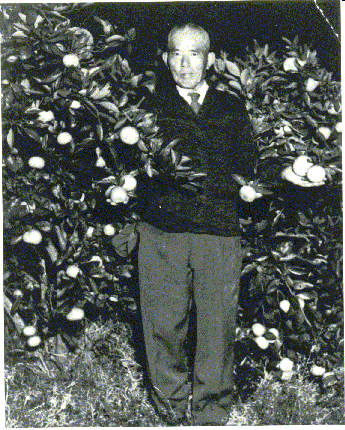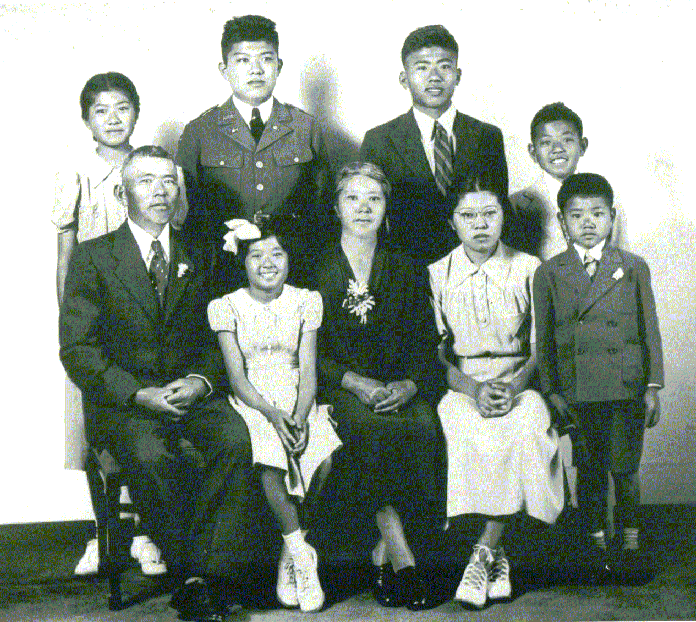Mitsutaro and Moto Kobayashi

(Courtesy of Hope Kobayashi) UT Institute of Texan Cultures
Mitsutaro was born in 1877 in a settlement called Shinya, a suburb of the city of Fukuyama which is in the Hiroshima prefecture. He was a mechanical engineering graduate of Kuramae Technical College, now Tokyo Institute of Technology. However, even with this high level of education, as he was not the eldest son, he would not get any ownership of land in Japan. Thus, Mitsutaro turned to immigration as an opportunity for him to continue family ownership of land and seek his own fortune. He left Japan on a British ship in the company of the president of Kuramae Technical College and arrived in San Francisco on August 3rd, 1904. After the San Francisco earthquake in 1906, he moved to Webster where he initially worked for Seito Saibara.
After some time, Mitsutaro decided to purchase twenty acres of land in Webster and planted Satsuma oranges that he ordered from Nagoya, Japan. Unfortunately, his orange orchards failed in 1911 when a freeze killed his trees. However, he had planted cucumbers between the orange trees which grew successfully. With the successful growth of these cucumbers, he was able to grow his business which would grow to encompass the cultivation of okra, carrots, asparagus, cantaloupe, strawberries and many other vegetables and fruits.
Because of his prosperity, he wrote his family in Japan to send a “picture bride”. In 1913, Moto Shigeta, Mitsutaro’s “picture bride”, of Osaka arrived in America and met Mitsutaro in Colorado Springs. Although their marriage had been officially performed in absentia in Japan, they met for the first time in Colorado and spent their honeymoon with a trip up Pike's Peak [1].
Moto Shigeta was born in Obama, Japan on November 13, 1889 into a prosperous family whose business was whale oil for lamps. She remembers that as a little girl she had her own maid who in evenings carried Moto's lantern for her. Showcasing further her upbring, she was trained from an early age in the tea ceremony.

Riki in Moto's arms, children from left, Hope, Lily, Ty (father of John and Kathy), and Tokuye
At the turn of the century came the first major change in Moto’s life. Kerosene replaced whale oil for lamps, and her family was left without a source of income. Moto, because of her intellectual capability, was sent to the Christian School Baika in Osaka. At this Congregationalist school she learned not only regular academics, but also calligraphy, flower arranging, cooking, and poetry.
Moto's journey to the little farmhouse in Webster marked more change and was somewhat difficult at first. While twenty-four-year-old Moto was a graduate of Osaka Christian College, where she was taught English, she still had trouble communicating in anything but Japanese. Because of this, she relied almost exclusively on her husband in her dealings with the non-Japanese community around Webster [1]. Furthermore, she now had to learn to cook on a kerosene stove while learning a new language, climate, and culture. However, through all this hardship, Moto held on to her values of hard work and discipline.
Adding to the difficulties faced, Kobayashi's first child, Thomas, died shortly after birth. So, when their first daughter was born in 1916, the couple were especially grateful. To commerate this important moment and show their hope for their future, the Kobayashis named their daughter Hope. Following this, Moto bore 4 more sons and 2 more daughters.
Moto worked hard on the management of the farm. Since Mitsutaro was often busy with marketing produce, Moto would take the orders from harvesting and give directions to the field workers while Mitsutaro was marketing in Houston. She would do this work on top of keeping the house, looking after her children, and cooking for a family of nine.

Top row (L-R): Lily, Tokuye, Ty, and Riki
Bottom row (L-R): Mitsutaro, Mitsu, Moto, Hope, and Herbert, May 1937
(Courtesy of Hope Kobayashi) UT Institute of Texan Cultures
Even with having to cook for a large family, Moto was an excellent cook fixing both Japanese and American food. Her children especially remember her sushi, rump roast and turkey with stuffing recipes. Moto was also a person of laughter. She always greeted people with bow, and when she lifted her head, there was always a huge smile. To further express herself, Moto wrote Japanese poetry. In the poetry we see her strength, her humor, her thanksgiving. Here are a few translated into English.
On Moon surface
hear voice of
person walking (on TV)
I open door
to make sure
it is same moon.
Moon
explorers
go on
expedition
Apollo
brave men
bring back stone
souvenir.
Dr. Overstreet made
old age body well
again.
You brave doctor
I honor this
Happy Day.
Especially important to Moto were the set of values she carried around. Moto valued education. With both her and her husband having received training, she knew her children must. The children remember their life structured by school, chores and study. However, this method of education paid off as all seven children attended university, with five of the children receiving college degrees. With these degrees the children contributed to the fields of chemical and aerospace engineering, medicine, as well as farming.
Moto especially loved and valued family. She deeply loved her husband of 49 years. When he died in 1962, she said she might die within three years of a broken heart. But, she also said if she lived through those years, she didn't know how long she would live as she would give her all towards her children. In this she was right: Moto lived a long life because she valued family; so, in turn her family honored her. She lived because Hope was there daily giving to her. She lived because Lilly was there to nurse her. She lived because Mitsu would come home from Japan each year to continue Moto’s connection with Japan. She lived because Riki and Herbert would stop by to give support. Moto deeply loved her family, and they loved her.
While Moto experienced many changes, she held onto her values and she held on to the value of the land. In Japan the Kobayashi family has owned the same land for over 400 years. Similarly, Moto would not sell the land; she would not give up the dear farmhouse she had moved into in 1913. Thus, the family would only lease the land. Moto would talk to neighbors who sold property saying, "You are so rich now. We are not rich; we just get the money once a month." Instead of pursuing riches, Moto valued the land more.
Life was not always pleasant. During the beginning of WWII, there was the internment of Japanese. Furthermore, Moto had several illnesses, but she always came home from the hospital. Moto experienced many challenges, yet, throughout it all she demonstrated great strength.
References
1. Walls, Thomas K. (1987) The Japanese Texans, San Antonio: University of Texas, Institute of Texan Cultures at San Antonio, 1996.
2. Allton, J.H., Brackett, P.M., and Ray, D., The Little White Church on NASA Road 1 - From Rice Farmers to Astronauts, Webster Presbyterian Church, Webster, TX.
3. Kobayashi, Lee, (personal communications)
